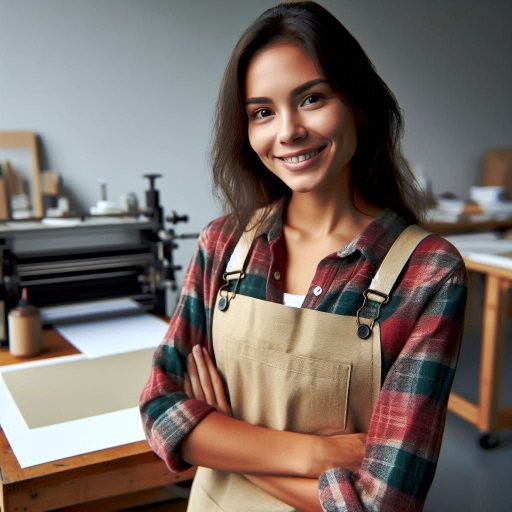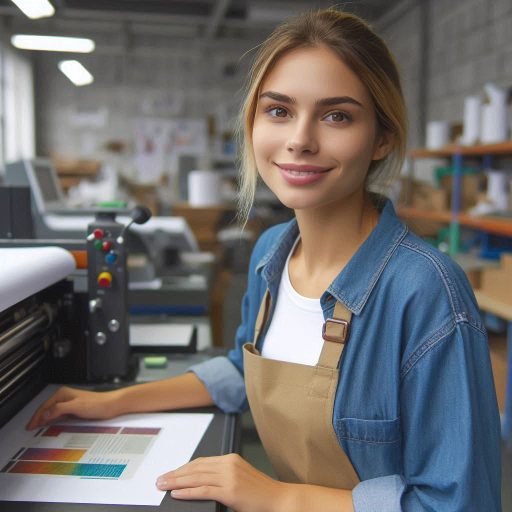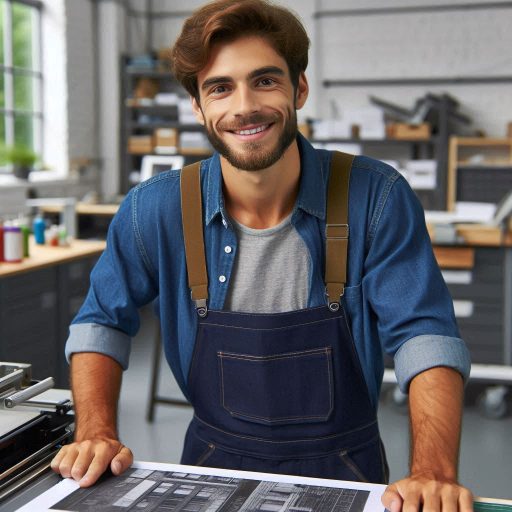Introduction
Printmaking holds a significant place in contemporary art.
This technique, which began in ancient times, has evolved dramatically over centuries.
Originating in China around the 9th century, printmaking started with woodblocks and later included metal engravings in Europe.
The Renaissance brought innovations like intaglio and etching, which revolutionized the art form.
Printmaking’s historical journey reflects its adaptability and importance.
Initially, it was a means of reproducing images for wider distribution.
Over time, artists embraced printmaking as a unique form of artistic expression.
By the 20th century, artists like Pablo Picasso and Andy Warhol used printmaking to challenge traditional boundaries and explore new techniques.
Today, printmaking is a vibrant part of the contemporary art scene.
It offers artists diverse methods to experiment with textures, colors, and forms.
This medium allows for the creation of multiple artworks from a single plate, making art accessible and democratized.
Printmaking’s role in contemporary art includes its ability to blend traditional techniques with modern innovations.
It enables artists to produce work that is both innovative and grounded in historical context.
In summary, printmaking’s historical evolution underscores its enduring relevance.
Its ability to combine tradition with contemporary practice makes it a cornerstone of modern artistic exploration.
Definition of Printmaking
What printmaking is and how it differs from other art forms
Printmaking is a form of art where an image is created on a matrix and transferred to a surface.
Unlike painting or sculpture, printmaking allows for multiple copies of the same image to be produced.
Various techniques are used in printmaking, such as etching, lithography, and silk screen printing.
Various techniques used in printmaking
Etching involves using acid to create an image on a metal plate, which is then inked and transferred onto paper.
Lithography uses a smooth stone or metal plate with a grease-based image that is transferred to paper through a press.
Transform Your Career Today
Unlock a personalized career strategy that drives real results. Get tailored advice and a roadmap designed just for you.
Start NowSilk screen printing involves pressing ink through a mesh screen onto paper, allowing for vibrant and detailed prints.
Importance of traditional printmaking methods in contemporary art
Traditional printmaking methods provide a foundation for contemporary artists to build upon and innovate.
By mastering these techniques, artists can explore new ways of creating and pushing the boundaries of printmaking.
The history and craftsmanship of traditional printmaking methods add depth and meaning to contemporary art pieces.
Read: Marketing Strategies for Printmakers
Evolution of Printmaking in Contemporary Art
Printmaking, as a traditional art form, has seen a significant evolution in contemporary art.
With advancements in technology and changing trends in the art world, printmaking has adapted to stay relevant and innovative.
Adaptation to Modern Technology
Printmaking techniques have evolved to incorporate digital technologies, offering artists new tools and methods to create prints.
Digital printing allows for precise and detailed reproductions, expanding the possibilities for artists to experiment and manipulate their work.
Furthermore, the accessibility of digital platforms has enabled artists to reach a wider audience and showcase their printmaking creations online.
Social media and online galleries have become essential spaces for artists to share their work and connect with other creatives in the field.
Pushing the Boundaries of Traditional Printmaking
Contemporary artists are not only utilizing digital technologies but also experimenting with mixed media to push the boundaries of traditional printmaking.
By combining different techniques and materials, artists can create unique and visually striking prints that challenge conventional methods.
Some artists blend photography, collage, or sculpture into their prints.
They create multidisciplinary works that merge traditional and contemporary art forms.
This fusion of mediums adds depth and complexity to the final piece, making it more engaging and thought-provoking.
Innovative Artists in Printmaking
Kara Walker
Kara Walker is known for her intricate and provocative prints that address themes of race, gender, and power.
Her silkscreen prints often depict scenes of historical significance, challenging viewers to confront uncomfortable truths about society.
Julie Mehretu
Julie Mehretu’s abstract prints combine architectural elements, geometric shapes, and vibrant colors to create dynamic and visually stunning compositions.
Showcase Your Business Today
Reach thousands of readers actively exploring professional services. Publish your business profile and grow your audience now.
Publish NowHer layered approach to printmaking results in intricate works that invite viewers to explore and interpret the complexities of her art.
Trenton Doyle Hancock
Trenton Doyle Hancock’s prints feature fantastical characters and narratives inspired by comic books, pop culture, and personal experiences.
His use of bold colors and playful imagery infuses his prints with a sense of whimsy and imagination, captivating viewers of all ages.
In fact, the evolution of printmaking in contemporary art has allowed artists to explore new techniques, experiment with mixed media, and push the boundaries of traditional methods.
By embracing modern technology and innovative approaches, artists continue to create captivating and thought-provoking prints that resonate with audiences worldwide.
Read: Printmaking for Children’s Art Education
Accessibility and Reproducibility
How printmaking allows for the creation of multiple copies of an artwork
Printmaking, as a medium, offers artists the ability to produce multiple copies of their work.
This process involves transferring an image or design onto a surface, such as paper or fabric, through various techniques like etching, lithography, or screen printing.
The ability to reproduce artworks in this way has had a profound impact on the accessibility of art to a wider audience.
How this accessibility has democratized art and allowed more people to engage with and collect art
By allowing artists to create editions of their work, printmaking has democratized the art world.
Before the advent of printmaking, collecting art was a privilege reserved for the elite and wealthy.
Original paintings and sculptures were scarce and often too expensive for the average person to afford.
However, with printmaking, art became more affordable and accessible to a broader range of people.
Impact of printmaking on the art market and art collecting practices
Printmaking has also transformed the art market and collecting practices.
The creation of multiple copies of an artwork means that more people can own a piece of art, unlike unique original paintings that are usually confined to private collections or museums.
This accessibility has contributed to a more diverse and inclusive art market, where individuals from different socio-economic backgrounds can engage with and appreciate art.
Furthermore, printmaking has opened up new opportunities for artists to reach a global audience.
Editioned prints can be distributed and showcased in galleries, art fairs, and online platforms, making it easier for artists to gain visibility and recognition.
The reproducibility of printmaking allows artists to share their work with a wider audience and build a larger collector base.
Moreover, printmaking has influenced the way we perceive and value art.
While original artworks still hold a special value due to their uniqueness and rarity, prints have become a popular and collectible art form in their own right.
Collectors are drawn to the affordability and accessibility of prints, as well as the opportunity to acquire works by renowned artists at a fraction of the cost of an original piece.
In short, the accessibility and reproducibility of printmaking have revolutionized the art world by making art more democratic, inclusive, and attainable.
Printmaking significantly impacts the art market and collecting practices.
It shapes how we create and consume art today. Collectors and artists adapt to this evolving medium.
Printmaking continues to influence contemporary art appreciation and valuation.
Read: Tips for Setting Up a Printmaking Studio

Collaborations and Cross-disciplinary Approaches
How printmaking encourages collaborations between artists, printers, and other creative professionals
Printmaking serves as a medium that fosters collaborations among artists, printmakers, and other creative professionals.
The collaborative nature of printmaking allows for the exchange of ideas, techniques, and expertise, resulting in unique and innovative artworks.
How printmaking is often used in conjunction with other art forms
Furthermore, printmaking is often used in conjunction with other art forms such as painting, sculpture, and installation.
This integration of printmaking with various disciplines enhances the visual language and conceptual depth of the artwork.
Examples of Successful Interdisciplinary Projects
- Printmaking and Sculpture: Renowned artist Louise Bourgeois incorporated printmaking techniques into her sculptural works, blurring the boundaries between two-dimensional and three-dimensional art.
- Printmaking and Painting: The collaboration between painter Helen Frankenthaler and printmaker Ken Tyler resulted in a series of innovative prints that merged aspects of painting and printmaking.
- Printmaking and Installation: Installation artist Olafur Eliasson often integrates printmaking elements into his immersive installations, creating multidimensional spaces that engage the viewer on multiple sensory levels.
- Printmaking and Photography: Photographer Ansel Adams collaborated with printmakers to create stunning lithographic prints of his iconic landscapes, showcasing the synergy between photography and printmaking.
These examples illustrate how printmaking transcends traditional boundaries and collaborates with various art forms to produce dynamic and thought-provoking works of art.
By embracing cross-disciplinary approaches, artists are able to explore new possibilities and push the boundaries of artistic expression.
In general, collaborations and cross-disciplinary approaches play a crucial role in the contemporary art world, and printmaking serves as a catalyst for these innovative partnerships.
Printmakers collaborate with artists from diverse disciplines.
They expand art’s horizons through these partnerships.
They create groundbreaking works that challenge norms. Their art inspires new visions and ideas.
Read: Understanding Color Theory in Printmaking
Social and Political Commentary
How printmaking has been utilized by artists to comment on social issues, politics, and cultural movements
Printmaking has been a powerful tool for artists to address social issues, politics, and cultural movements.
It offers a platform for artists to express their views and engage audiences in critical conversations.
Showcase Your Business Today
Reach thousands of readers actively exploring professional services. Publish your business profile and grow your audience now.
Publish NowPrintmaking plays a crucial role in spreading messages and raising awareness about important societal issues.
Artists use prints to evoke emotions, provoke thoughts, and challenge the status quo in contemporary art.
Role of Printmaking in Social Commentary
Printmaking serves as a visual medium to communicate complex ideas and narratives effectively.
Artists have historically used prints to challenge power structures, advocate for marginalized communities, and critique social injustices.
Prints have the ability to reach a wide audience and have a lasting impact on society.
Examples of Impactful Prints
Barbara Kruger’s iconic prints with bold text and imagery that critique consumerism and gender roles.
Shepard Fairey’s “Hope” poster featuring Barack Obama, which became a symbol of political activism and hope.
Kara Walker’s silhouette prints addressing race, slavery, and identity in a provocative and thought-provoking manner.
Banksy’s politically charged prints that challenge authority and question societal norms with wit and humor.
In review, printmaking in contemporary art serves as a powerful tool for social and political commentary.
Artists use prints to spark conversations, raise awareness, and advocate for change in society.
By addressing important issues through their work, artists can inspire others to reflect, engage, and take action towards a more inclusive and just world.
Preservation and Conservation
Preserving printmaking techniques and artworks is crucial for future generations to appreciate and study the history and evolution of this art form.
Importance of Preservation
- Preserving printmaking techniques ensures that traditional methods are not lost to time.
- It allows artists to learn from the past and build upon established practices.
- Preservation helps maintain the authenticity and integrity of historical artworks.
- Future generations can explore the cultural significance of printmaking through preserved artworks.
Challenges of Conservation
- Printmaking materials like inks and paper are susceptible to deterioration over time.
- Handling and storing prints require specialized knowledge and care to prevent damage.
- Exposure to light, humidity, and temperature fluctuations can accelerate the degradation of prints.
- Conserving prints with colorfast inks and archival paper adds complexity to preservation efforts.
Organizations and Initiatives
- The Print Council of America is dedicated to promoting awareness and scholarship in printmaking.
- The American Institute for Conservation offers resources and training for conserving print artworks.
- Many museums and galleries have conservation departments focused on preserving print collections.
- Initiatives like the Global Printmaking Network connect professionals to share best practices in conservation.
Preserving and conserving printmaking techniques safeguard the art’s legacy.
These efforts ensure the art form’s value for future generations.
By addressing challenges, we support printmaking initiatives.
We continue to learn from printmaking’s rich history.
Conclusion
Printmaking continues to play a significant role in contemporary art by offering a unique and versatile medium for artists to express their creativity.
From traditional techniques like etching and engraving to modern innovations such as digital printing, printmaking has evolved to remain relevant in today’s art world.
The diversity of printmaking practices allows for a wide range of artistic styles and expressions, making it a dynamic and exciting field to explore.
Printmaking invites artists to explore new visual forms.
Artists push boundaries with limited edition prints and artist books.
They experiment with large-scale installations and innovative techniques.
Each method offers endless possibilities for creative expression.
As we reflect on the key points discussed in this blog post, it becomes evident that printmaking continues to hold its own in the contemporary art scene.
Its historical roots, coupled with its adaptability to changing technologies, make it an enduring and important medium for artists to engage with.
Therefore, I encourage readers to delve deeper into the world of printmaking and appreciate the rich tapestry of techniques and approaches that artists are using today.
By exploring the depth and breadth of printmaking practices, we can gain a greater appreciation for its continued relevance and importance in shaping the visual landscape of contemporary art.
[E-Books for Sale]
The Big Book of 500 High-Paying Jobs in America: Unlock Your Earning Potential
$19.99 • 500 High-Paying Jobs • 330 pages
Explore 500 high-paying jobs in America and learn how to boost your career, earn more, and achieve success!
See All 500 High-Paying Jobs of this E-Book
1001 Professions Without a Degree: High-Paying American Jobs You Can Start Now
$19.99 • 1001 Professions Without a Degree • 174 pages
Discover 1001 high-paying jobs without a degree! Unlock career tips, skills, and success strategies for just $19.99!




